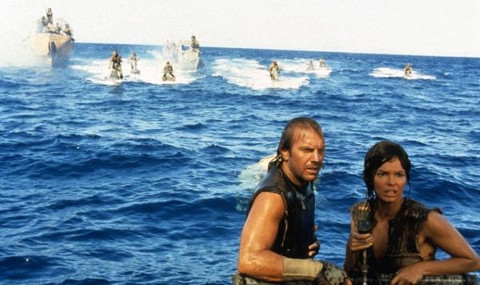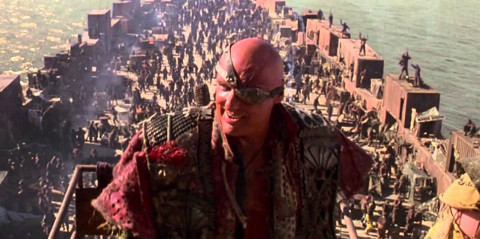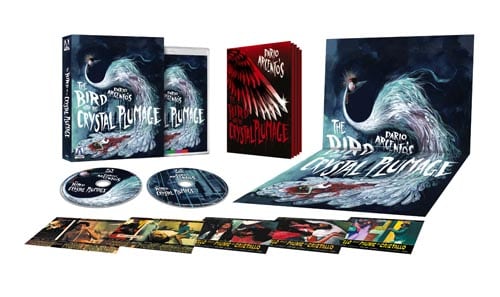Waterworld (1995)
Directed by: Kevin Reynolds
Written by: David Twohy, Peter Rader
Starring: Dennis Hopper, Jeanne Tripplehorn, Kevin Costner, Tina Majorino
USA
AVAILABLE ON BLU-RAY: 21st January, from ARROW VIDEO
RUNNING TIME: 135 mins/175 mins
REVIEWED BY: Dr Lenera, Official HCF Critic
Long after the melting of the polar ice caps in the 21st century, the sea levels have covered every continent on Earth. The remains of human civilization live on ramshackle floating communities known as atolls, though many believe that somewhere exists “Dryland’. Lone drifter The Mariner arrives at an atoll to trade dirt, a rare commodity, for other supplies, but is nearly drowned for having gills and webbed feet. Just then, the atoll is attacked by the Smokers, a gang of pirates seeking a girl named Enola who, according to their leader the Deacon, has a map to Dryland tattooed on her back. Enola’s guardian Helen rescues the Mariner and insists that he take the two of them to Dryland….
It’s often said that Waterworld was largely disliked when it came out in 1995 and has only became a favourite of many more recently, but I’m not sure that’s entirely true. There was a hell of a lot of bad press about the film, due to the reasons described below, and also because the knives often come out when somebody has had great success and seemingly needs to be taken down a notch or ten. It was never going to recoup its huge cost, but it was quite popular with audiences, and patrons of the cinema where I worked at the time tended to like it. I’ve always seen it as a rather good example of its kind [far more than just Mad Max at sea] with one particularly unique element – it’s almost entirely set on water and was even shot mostly on water – and if anything it holds up even better now because one can more fully appreciate the work that went into the production design – they actually built and used most of the diverse array of sea vehicles you see in the film rather than creating them digitally – and there’s not even much in the way of rear projection compared to many films of the time. Much of what you see is being done for real. There’s not really much plot, but a case can sometimes be made for simplicity, and at its best Waterworld does just about achieve the mythic grandeur it often seems to be striving for. The action sequences are excellent and this future world has real grit to it and is about as convincing as they could have made it. Aside from some major script holes, for me the only major flaw is the perennially one-dimensional Kevin Costner, obviously struggling with his very grouchy, even dislikable [for much of the film] hero role that so many other stars could have given justice too.
It was the fourth collaboration between Costner and director Kevin Reynolds. The first screenplay by Peter Rader was for a more fantastical and even comical : rewrites by David Twohy made it much more serious. Costner insisted that Reynold direct instead of Robert Zemeckis. Samuel L. Jackson, Gene Hackman, James Caan, Gary Oldman, Gary Busey and Laurence Fishburne all turned down the part of the Deacon. Filming mostly took place in a large artificial seawater enclosure just off the coast of Hawaii where people had to be ferried to a barge by the shore to use the toilet, with extra bits shot at Santa Catalina Island and Huntington Beach, California. Costner personally invested $22 million of his own money into the film, though that didn’t help much when production costs ran to an estimated $175 million, way over the authorised budget of 100 million. Heavy winds would disrupt shots, hurricane alerts caused filming to shut down three times, and an actual hurricane did destroy some of the set. Jeanne Tripplehorn and Tina Majorino nearly drowned on their first day of filming when the trimaran [a boat with one large hull and two small ones] they were on sank, dragging them behind it, while we nearly almost lost Costner too when he got caught in a squall while tied to the mast of his boat. Depending on who you believe, Reynolds either walked because Costner kept trying to take over, or was fired because he resisted the studio’s insistence that the film be much shorter. Costner directed some of the film, also hiring Joss Whedon to do some rewrites, then cut 45 minutes from the three hour original cut. Contrary to popular opinion, and despite all the negative press [which was also due to Costner having a fling that broke up his marriage], Waterworld reached number one in its debuting week.
We zoom in on the trademark Universal globe and see land disappearing [okay, poor digitals here, but it was 1995] while just two lines from a voice over set the scene. Now our first shot of our hero should set the tone. I’m not entirely sure if Waterworld’s does, but it’s fairly original and tells you a lot about not just the Mariner but this world in general, and does it assuming that the viewer is intelligent enough to work stuff out. You wouldn’t get a hero introduced in such a manner in a film today. Before we’ve properly seen his face, we witness the Mariner peeing into a bottle, pouring the fluid into a home-made chemistry set, cranking a handle to process it, and then drinking it. Then he gargles, and spits on his little lime tree, so we know how he gets both fresh water and vitamin C. Pretty much everything tends to be scarse in this world you see, and survival depends largely on what you can swap with other folk you come across. There’s hardly anything that isn’t for sale. The Mariner comes across another drifter who steals the fruit from his plant while he’s underwater, so he capsizes his boat and leaves him to the Smokers, pirates led by the Deacon, their “humble benefactor, spiritual shepherd and dictator for life”. He’s played by Dennis Hopper who again exercises his rare skill of being frightening, mad and funny all at the same time. He does ham it up, but considering some of the lines he’s given that seems appropriate. “If you notice the arterial nature of the blood coming from the hole in my head, you can assume that we’re all having a real lousy day” he says when he’s just lost one eye due to the Mariner and the little girl Enola with the map to Dryland on her back seems to have got away. He’s a joy to watch throughout and, similar to the late Alan Rickman who hadn’t long done a similar thing in a certain other big Costner movie not long before this one, virtually steals the film from its star.
During the attack on the atoll by the Smokers which gives us such sights as water skiers pulled by rusty old planes up ramps and over walls, the Mariner, Enola and her guardian Helen escape and set off for Dryland. Much time is devoted to the three on the Mariner’s trimaran, and some may feel that this material could have been cut down, but I love the interplay between these characters. Much tension is created because the Mariner, who’s been regarded as a freak all his life, dislikes humans and doesn’t want these people on his boat, even throwing Enola overboard [the threatening and violent way that this young child is treated throughout including even having a match struck on her face probably wouldn’t pass today]. But you just know that there will be a moment when the Mariner sees the light. I love when this happens in a movie, and it doesn’t disappoint in this one, though the transformation of the relationship between the Mariner and Enola perhaps happens too quickly [I’d have been happy if there had been more of these scenes, rather than less], but there are nice touches, such as Enola’s liking for drawing all over the boat which later becomes a major plot point. The Mariner/Helen relationship by contrast doesn’t seem entirely thought through and their ‘romance’ [if one can call it that] is rather cold, though I like the underwater giving of oxygen that’s also a kiss, and Jeanne Tripplehorn gives it her all which makes up for Costner’s weakness. 12-year old Tina Marjorina is also strong as Enola, perhaps her best moment being when she’s been kidnapped and talks of the Mariner to her kidnapper as a virtually superhuman being. Despite having been horrible to her earlier, he’s now an almost mythical hero to this child. Of course we do still get encounters with other denizens of this world including another drifter exuberantly played by Kim Coates who’s gone rather mad from being at sea for so long and who creepily lusts after not just Helen but Enola too, while the Smokers are on their trail. There’s even a sea monster, though the scene it’s in is really brief and the creature just a source of food. Perhaps that’s just as well, as it’s the poorest effect in the film.
There’s the awe-inspiring scene featuring fantastic miniature work when the Mariner decides to show Dryland to Helen and takes her underwater to a submerged city, with grand scoring by composer James Newton Howard enhancing the wonder. Oddly but quite satisfyingly, the final ten minutes don’t contain any action at all, just a sense of the story coming to its natural close. One may of course ask some questions. Why is dirt so important? How come bullets and cigarettes can be usable a century or so after their manufacture date, and in humid and watery conditions? How come nobody can find an island that would be more visible from a greater distance than all these atolls everyone knows about? And can you really move an oil tanker by rowing? But one can also appreciate a great deal, and I’m not just talking about the chases and battles that are full of great explosions and Costner giving his character as much heroics and cool things to do as possible [usually set to a very heroic music theme], as well as some seriously Shane-like moments elsewhere. They set out to craft an entire mind frame that comes about from living your whole life on the water, with characterisation and logic stemming from there, from the Drifter’s policies to the Smoker’s screwed up perspective on anti-conservationism. This was really quite ambitious and we can therefore almost forgive some of the things that don’t make sense. There are many great details big and small that often aren’t made a big deal out of, like The Mariner wearing a computer chip as a necklace, a Rolex watch as a wristband, and ski boots on his feet. And that trimaran of the Mariner’s is seriously cool even if its speed and agility isn’t believable. I wish that this film had been a smash so we could have had Waterworld toys. I’d probably still own them.
Reynolds hasn’t really received his due as a director of action at least – it’s realistically chaotic but still easy to follow and you can see everything properly. He also makes sure the cameraman gives us lots of aerial shots to look down upon the mayhem and the vistas. Mark Isham originally scored this film but his work was rejected. I doubt it was as good as Howard’s work which still remains one of his best soundtracks, combining typical orchestral excitement with more plaintive stuff, some of it with a slight New Age-y feel. Maybe, all things considered, Waterworld was still something of a folly, but you certainly can’t say that a hell of a lot of the money isn’t up on the screen. A good example of the Hollywood blockbuster at its most ambitious and showman-like, yet also just eccentric enough to make watching it always an interesting experience, Waterworld has improved with age – but then again it was always pretty good in the first place.
Rating: 









I don’t own the previous Blu-ray from Universal, but I have no reason not to believe that this is not as much of an improvement as was Arrow’s Blu-ray of 12 Monkeys, also previously released in the format by Universal. Mostly brightly lit and full of close-ups including many of just objects, Waterworld is possibly a hard film to get to look totally right on Blu-ray, but Arrow have done a stunning job with it. Only some of the back projected backgrounds don’t look too good, but it’s possibly a sad thing with these restorations and the Blu-ray format that these stick out more now. Skin tones look very natural and grain management is stable. Very good indeed.
Arrow have also made up for the fact that all previous releases of the film were vanilla. The big extra is Maelstrom: The Odyssey of Waterworld, a pretty lengthy detailing of the conception, making of and release of Waterworld. Unfortunately none of the cast appear [though did anyone expect Costner to turn up?], and nor does Twohy, but Reynolds certainly appears continuously. He, Rader, producer Charles Gordon and journalist Justin Humphries appear most, but many other crew members show up to talk about their part in the creation of the film and their perspective on it, and after a while the absence of cast members ceases to matter that much. The setbacks that happened on set are played down and some not even mentioned, though it seems possible that the press did make a few things up considering that we hear of an instance where a magazine claimed that three cameramen were killed during filming! It’s clear that they were after Waterworld right from the start. You do get a lot of information on how many of the set pieces were shot, and film clips, behind the scenes clips and production drawings intersperse the talking heads. Consistently interesting if slightly ‘restrained’.
Arrow have also included Dances With Waves, a typical promotional featurette featuring sound bites from the main cast members and the director, along with some enticing footage of scenes being shot which you just want to see more of. Majarino describing the huge set as “the coolest place in the world” and the revelation that Costner did as many of his own stunts as he was allowed are highlights. Some of this material turned up in the documentary. Global Warnings looks at similarly themed ecological end of the world efforts. You’ll have heard of and even probably seem most of the films looked at which include such classics as Things To Come and The Time Machine, but it’s a relaxing watch with a few interesting observations.
And now we come to….also on this release….
WATERWORLD: THE TV CUT
I still remember my joy quite a few years ago when I looked to see what was on the Sci-Fi Channel one day and noticed that a showing of Waterworld appeared to be considerably longer than normal even allowing for advert breaks. This version, almost the same as Reynolds’s original cut, did not disappoint and I believe that it’s considerably better than the theatrical cut even allowing for the very stringent censorship of the time so that it could be shown at any time during the day. They removed all mild swearing, most of the [also mild] violent shots, the ‘from the back’ nudity of Jeanne Tripplehorn’s body double, and even the opening of the Mariner peeing. Some alternate takes were also used in this respect. However, none of this made much difference to the experience of watching the film and the cuts/changes were done with some care. And what we got in exchange was quite something.
This version obviously moves a little slower, though not as slower as you may expect. The majority of the additions are worthwhile, starting with the first meeting of the Mariner and Helen which is more substantial, and some even correct flaws present in the theatrical cut. Most notably, you find out how on earth the Mariner obtained a jet ski, and how Gregor found Helen and the Mariner after their boat was burned down. The Mariner’s relationships with both Helen and Enola evolve more naturally and it’s revealed that the Mariner’s true change of heart is much later. The final farewell is more emotional, and how on earth could they have cut the revelation of a certain plaque right at the end? It’s a great moment. There are also some nice camera pans that were removed or cut to quick static shots.
I have a tendency to prefer longer version of films I really like even they’re not much better than the theatrical versions. For example, I love the extended cut of Superman The Movie so much that it’s become my version of choice, but I’m not going to pretend that any of the additions are essential and actually improve the film. But with Waterworld, I genuinely believe that in its longer cut it’s an even better film. And Arrow have not only given us this TV cut, but also the “Ulysses” cut which was originally put together by a fan, and which restores all the censored material to the TV cut. Thinking sensibly, I guess that the perfect version would be midway between the Ulysses cut and the theatrical cut, including all the beneficial material I described but maybe tightening some bits elsewhere – though where would you start? Some Hopper and boat footage could be sacrificed for pacing reasons, but this is some of the best stuff in the film!
So in conclusion? A flawed but fascinating high point of ’90s blockbuster filmmaking before computers took over in a brilliant restorations and in three versions, plus a fine ‘making of’ documentary and some other bits – of course the Doc Highly Recommends !
THREE-DISC LIMITED EDITION CONTENTS
*Three cuts of the film newly restored from original film elements by Arrow Films
*Original 5.1 DTSHD Master Audio and 2.0 stereo audio options
*Optional English subtitles for the deaf and hard of hearing
*Six collector’s postcards
*Double-sided fold-out poster
*Limited edition 60-page perfect bound book featuring new writing on the film by David J. Moore and Daniel Griffith, and archival articles
*Reversible sleeve featuring original and newly commissioned artwork by Paul Shipper
DISC ONE – THE THEATRICAL CUT
*High Definition Blu-ray (1080p) presentation of the original theatrical cut
*Maelstrom: The Odyssey of Waterworld, an all-new, feature-length making-of documentary including extensive cast and crew interviews and behind the scenes footage [102 mins]
*Dances With Waves, an original archival featurette capturing the film’s production [9 mins]
*Global Warnings, film critic Glenn Kenny explores the subgenre of ecologically themed end-of-the-world films [22 mins]
*Production and promotional stills gallery
*Visual effects stills gallery
*Original trailers and TV spots
DISC TWO – THE TV CUT [LIMITED EDITION EXCLUSIVE]
*High Definition Blu-ray (1080p) presentation of the extended US TV cut, which runs over 40 minutes longer than the theatrical cut
DISC THREE – THE “ULYSSES” CUT [LIMITED EDITION EXCLUSIVE]
*High Definition Blu-ray (1080p) presentation of the extended European “Ulysses” cut, which include previously censored shots and dialogue
(102:22)
“Dances with Waves” archival making-of (9:20)
“Global Warnings” film critic Glenn Kenny explores the subgenre of end-of-the-world Hollywood blockbusters (22:21)








Be the first to comment